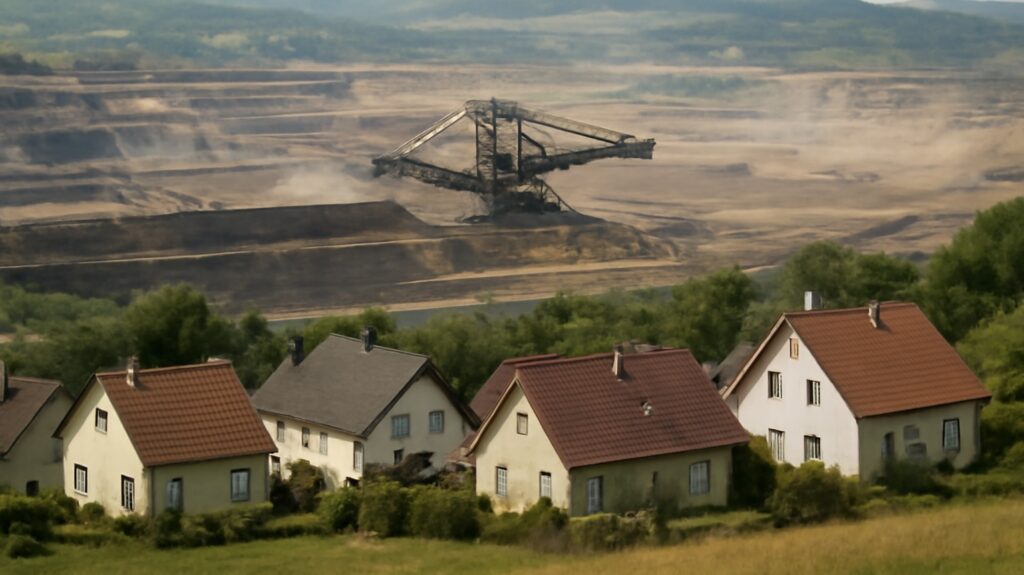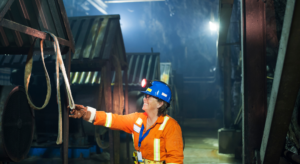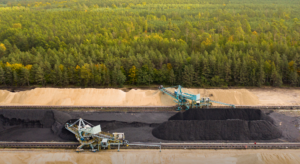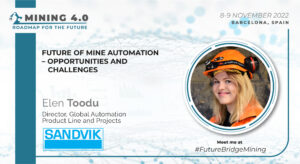Ever wonder what keeps everything running? The minerals that power clean energy and tech don’t just show up on their own. They come from European mining, which provides the raw materials the world depends on. Yet right across the continent, a major hurdle keeps rising: intense local public opposition to mining projects Europe faces every time a new site is proposed. This reaction, known as the NIMBY syndrome, has deep roots in history, local economies, and organized resistance. This article looks at why that opposition exists and shows how to get social license for mining through practical, community-driven approaches.
Not in My Backyard Syndrome: The Roots of Local Opposition
When a new mine is planned, the hardest part usually isn’t the rock below the ground. It’s the people above it. Communities have memories, priorities, and fears that shape their response. This section breaks down the main reasons for resistance from historic scars to current economic worries and explains why earning trust is essential for community engagement for mining projects:
Public Perception and Historical Legacies
Many residents don’t view a new mine as a fresh start. They recall old accidents, community losses, and broken promises. In the Balkans, people haven’t forgotten the 2000 Baia Mare spill in Romania. The cyanide that got into the rivers really changed things. That memory still makes people wary of mining, even before a new company comes into the picture. Moreover, that living memory shapes how people respond to European mining. It also drives mining opposition born from the NIMBY syndrome and wider public opposition to mining projects Europe has seen for years.
For developers, that history means the starting line is far back. They have to show, not just say, how today’s practices differ from the disasters of the past. Clear data on water safety, visible investment in containment systems, and early third-party audits can chip away at suspicion. Furthermore, without this kind of concrete proof, people assume the worst and the fight over public opposition to mining projects Europe begins before a drill touches the ground. Acknowledging the past openly and showing respect for local memory is often the first real step toward community engagement for mining projects.
The Economic and Environmental Split
For people living near a proposed mine, the trade-offs aren’t abstract. They look at their water, their soil, and their daily routines. National leaders might promote new jobs or green-tech materials, but locals weigh dust, noise, and truck traffic. Furthermore, in farm regions, for example, Portugal’s Terras do Barroso, families worry a lithium mine could damage protected landscapes and erase their main income. So, that personal risk feeds mining opposition and reinforces NIMBY Europe feelings that their home is being sacrificed for someone else’s gain.
As a result, developers must address these fears directly. Transparent baseline studies, open town-hall meetings, and clear mitigation plans help people see concrete protections. Additionally, without visible action, distrust grows and public opposition to mining projects Europe intensifies.
The Social License to Operate (SLO)
A government permit opens a door, but it doesn’t guarantee welcome. The real gatekeeper is the community. Furthermore, this informal approval, known as the Social License to Operate, is earned through:
- Ongoing respect,
- Open information,
- And visible responsibility.
Across Europe, residents are organised and assertive. If they sense a company is only ticking boxes, support evaporates, and NIMBY Europe hardens into protests, lawsuits, and delays.
To build an SLO, companies must act early. Keeping things open, checking in regularly, and giving people a simple way to raise concerns shows you mean it. This stops rumours from flying around and shows you’re genuinely committed. Without them, no amount of investment can buy trust. Moreover, in practice, tackling the NIMBY syndrome means treating the SLO as a daily commitment, not a one-time hurdle.
The Rise of Anti-Mining Alliances
Opposition today no longer stops at the village hall. Local farmers, national environmental groups, and global NGOs link up, pooling expertise and reach. A neighbourhood worried about property values may team with an international group concerned about biodiversity. Social media then amplifies their message, giving public opposition to mining projects Europe a speed and scale unseen a decade ago. As a result, this web of support strengthens mining opposition and deepens the NIMBY syndrome.
For developers, ignoring these alliances is risky. Mapping stakeholders, building relationships with credible NGOs, and sharing real-time data can prevent small disputes from exploding online. Proactive community engagement for mining projects helps break echo chambers and shows residents there’s a listening partner. Without that, anti-mining networks dominate the story before a project even starts.
Public Opposition to Mining Projects Europe: The Mechanics of Resistance
Local resistance is not simply about rallying. It is a tactical process that employs a range of resources to block and slow down projects. This part goes inside the real-world ways communities and activists resist, from taking advantage of complex legal frameworks to employing new communication platforms:
The Role of Regulatory Obstacles and Permitting Delays
New mine opponents are masters at employing legal and regulatory structures for their purposes. They are aware that every new project has to undergo a lengthy permitting process. It includes environmental assessments and public comment periods. Activists take these steps as a powerful weapon to delay or even halt a project. Furthermore, they can file thousands of public comments and objections, which the regulators have to legally examine.
Moreover, they can dispute the scientific evidence in a company’s report and call for additional studies. If a permit is issued, they can go ahead and submit legal appeals, which will hold up a project in court for several years. This bureaucratic tactic creates a delay in permitting. These delays also increase the cost of the company and tend to make investors lose interest. So, this is a key component of the European mining opposition playbook.
Media Narrative and Information Dissemination
The media are very influential in setting the tone of discussion regarding new mining projects. Local media, in fact, can be extremely influential since they emphasize issues that affect a community at large. The opposition is excellent at tipping off journalists about how a mine will ravage a local river or damage a conservation area. They make use of social media to promote their message and rally people to attend rallies.
At times, such campaigns involve spreading misinformation to instill fear and uncertainty, and making it extremely hard for the company to voice its own version. For example, in most of Serbia’s anti-mining rallies against an intended lithium mine, social media was the key mobilizing tool for mass rallies that generated enough political pressure on the government. Additionally, the NIMBY syndrome is nurtured by such phenomena.
Property Values and Local Livelihoods
For most individuals, the dread of a new mine is a simple matter of money. They are concerned their property value will decline. This is a highly intimate concern. No one wishes to see their most important asset decrease in value. Rural communities have concerns that go far beyond that. The local communities, depending on tourism, agriculture, or traditional industry, are afraid that the mine will destroy their lifestyle.
A new mine might drive tourists away who come to enjoy the pristine countryside. It could also pollute the ground so that it is no longer possible to plant crops on it. The particular fears of homeowners are a key motivator of the NIMBY syndrome. Moreover, they perceive the project as a personal threat to their financial well-being and future. So, recognizing these quite legitimate concerns is an essential move towards understanding how to get social license for mining.
The Power of Supra-National Policies and Transnational Activism
National boundaries fail to hold back opposition to mining. Activists in Europe are increasingly resorting to EU-level policies and transnational networks to battle fresh projects. For instance, a community in one state may apply the EU environmental law, such as the Natura 2000 network, to oppose a scheme in another state. The EU’s advocating for a Green Deal has established a new political climate that activists are leveraging.
The more the EU discusses itself as a sustainability leader, the greater pressure there is on member states. Furthermore, transnational activist networks such as the one that developed around the Rosia Montana gold mine in Romania enable movements to exchange tactics, legal assistance, and money. This is a significant contributor to the expansion of the NIMBY Europe issue.
NIMBY Europe: Engagement and Mitigation Strategies
When confronted by vigorous local opposition, firms cannot rely on chance. They require an active/intelligent approach to manage issues and establish confidence. This section considers what works best in engaging with communities, leveraging technology, and modifying public opinion:
Proactive Stakeholder and Community Engagement
The most effective companies understand that you have to begin a dialogue way before you even reach for a spade to the ground. So, this means engaging in early/transparent discussions with all stakeholders. It includes:
- Community members,
- Local government officials,
- And environmental groups
It’s really about hearing them out and showing you care. You’ve got to break the project down in simple terms and be straight about what could go wrong and what could go right.
Rather than having a formal public hearing, firms ought to have smaller, more social gatherings. One good model of stakeholder engagement for mining projects is the Skellefteå project in Sweden. This is where firm Boliden interacted with the community for more than a decade. By this, they laid a solid base of trust. Additionally, such proactive thinking is the ingredient for overcoming the NIMBY syndrome.
Equitable Community Benefit Agreements
One of the best ways to demonstrate true commitment to a community is by establishing a Community Benefit Agreement (CBA). It is a legally enforceable agreement between the firm and the local population. Furthermore, it defines certain, concrete, and long-term economic and social gains. It is not merely about paying taxes or generating a few jobs.
A CBA can encompass things like money to construct a new school or establish a scholarship program for the local students. Moreover, it can even ensure that a part of the jobs and contracts are reserved for the locals. Such an agreement directly addresses the locals’ issues regarding economic gains. It also makes sure that the community benefits from the wealth generated by the mine. So, CBAs are an excellent means of developing a social license to operate.
Technological and ESG Transparency
New European mining operators have one huge advantage: technology. They can deploy real-time monitoring systems to monitor water quality and air pollution. They can make that data available to the public via online dashboards. This type of transparency fosters trust. Furthermore, it demonstrates that the firm is seriously dedicated to protecting the environment. When a resident can observe for themselves that the water is clean, it becomes much more difficult for critics to circulate rumors.
Also, having clear Environmental, Social, and Governance (ESG) goals matters. When a company has third-party-verified ESG targets, it shows they’re really committed to green practices. This is critical to the new European model for the mining business. It’s more than obeying the law. It acts like a commitment to being a good neighbor.
Reframing the Narrative – Mining as a Climate Solution
The mining industry stands before a great chance to change how people talk about it. Rather than merely speaking of extracting minerals, businesses can speak of supplying the raw materials Europe requires to combat climate change. They can speak of how the copper they dig out is crucial for wind turbines. They can speak of how the lithium they mine is necessary for electric vehicle batteries.
This approach reframes mining not as a pollution issue, but as a key component of the solution. By establishing this association, they are able to address a wider public. It shifts the debate from “a mine will damage our environment” to “this mine is required for a greener future.” Moreover, it is an effective means of achieving a social license to operate. It contributes to combating the NIMBY syndrome as well.
Not in My Backyard Syndrome: Case Studies & Future Outlook
Looking at examples from practice enables us to see what succeeds and what fails. This part considers both a successful and an unsuccessful project to extract some general lessons. We will also consider the larger context of international supply chains and the role of a circular economy:
Lessons from a Successful European Mining Project
The Skellefteå mining district in Sweden provides an excellent model for successfully finding one’s way around the NIMBY Europe phenomenon. The local firm, Boliden, has a long tradition of intensive interaction with the community. They have built strong ties with local interests and have been transparent about their operations for decades. Furthermore, they have invested heavily in clean technology and environmental stewardship as well.
The outcome is that the community has a lot of faith in them. When they initiate new projects, there is already a platform of trust. The local people experience the advantages firsthand. They consider mining to be a source of good salaries and an integral element of their local identity. So, the Skellefteå model shows that community involvement for mining ventures is a long-term endeavor. This is central to preventing the NIMBY syndrome before it begins.
The Stalled Project: A Cautionary Tale
A project in Serbia serves as a cautionary tale of what occurs when a firm does everything wrong. In this case, a planned lithium mine saw a great amount of public protests/political backlash. The organisation, Rio Tinto, did not go through with transparency when it came to details of the project. Also, many locals felt that they weren’t part of the whole conversation. Additionally, environmental groups & activists used this absence of trust to their advantage. They also generated rumors about contaminated water and the destruction of land.
The demonstrations were so massive that the government had to end the project. This cost the firm a great deal of money and time. As a result, this is a lesson in securing a social license to operate from the very beginning. You can’t just rely on a government license. You must gain the support of the people. Additionally, this parable demonstrates why opposition to mining is a strong force. This is a classic case of the NIMBY Europe syndrome.
Evolving Global Supply Chains and Their Local Impact
Geopolitical changes are making new demands on European mining. Nations understand that relying on other countries for key raw materials is a massive risk. So, pressure to move supply chains closer to home and de-risk relying on nations such as China is making new demands for opening more mines in Europe.
This makes a local project more than a local matter. It is a question of national and even European security. However, this larger picture argument does not always cut it with a local community that is concerned about its welfare. That is a massive challenge for governments and businesses. They must balance the requirement for those raw materials against the very real interests of the communities where such materials are located. Furthermore, this is where social license to operate comes into play as an increasingly significant consideration.
The Circular Economy and Future of European Mining
In the future, Europe’s long-term plan will combine new mining with a lot of pressure on a circular economy. By prioritizing material reuse and recycling, Europe has a chance to decrease its demand for new mines and alleviate some of the pressure. For instance, recycling retired EV batteries to recycle the lithium and cobalt would significantly reduce the need to extract new materials.
This is a very viable solution that will ease future NIMBY syndrome issues. A circular economy will eventually reduce the European mining footprint overall. The end goal is to be sustainable and self-sufficient without having to ruin new landscapes. Furthermore, more attention to reusing and recycling is an excellent way to reduce local opposition in the long run. This can also assist in addressing the issue of NIMBY Europe.
To Sum Up
Where do we go from here, then? The task of ensuring our future while honoring our communities is enormous. The era of doing business as usual is definitely behind us. So, the industry needs to begin to view local resistance not as an obstacle to be overcome but as a partner. The future of successful mining projects will be based on trust and mutual value. This is the thinking change that we need to achieve to secure the material we require and to establish a new, more sustainable industry.
Moreover, we are reaching a tipping point. The decisions we take today will determine our future for decades to come. So, attend the 8th Mining 4.0 Europe: Roadmap For The Future in Barcelona, Spain, on 6-7 November 2025 to meet industry players and professionals who are crafting the future of mining innovation. We anticipate your presence!





